SENSUIKAN!
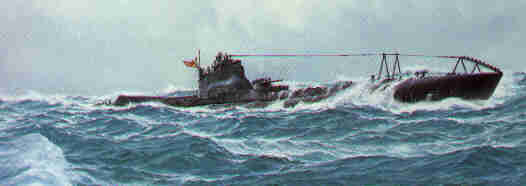
Midget Submarines at Diego Suarez, Madagascar
1942
© 2006-2008 Bob Hackett and Sander Kingsepp
Rev 1
11 December 1941:
Lt ( j.g.) Akieda Saburo, a pioneer midget submariner and
volunteer, sends a memo to the Kure Torpedo facility suggesting that nine Type A midget
submarines be rebuilt according to an improved standard ("Kai 1”).
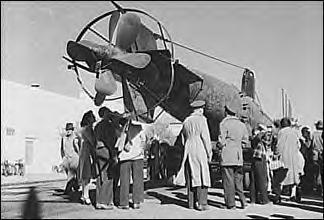 Captured Type A Midget Submarine
18 December 1941:
Captured Type A Midget Submarine
18 December 1941:
The Combined Fleet staff authorizes planning of a
midget submarine operation designated as "Divine Dragon Operation No. 2" against
the British Far Eastern Fleet. The operation is to be conducted between 20 May
and 10 June 1942.
3 January 1942:
Lt ( j.g.) Matsuo Keiu and Cdr (Rear Admiral,
posthumously) Ariizumi Tatsunosuke, liaison officer from the Naval General
Staff, participants in the planning conference for Divine Dragon Operation No. 1
- the midget submarine attack on Pearl Harbor - arrive aboard flagship NAGATO to
discuss details of the pending operations with Admiral (Fleet Admiral,
posthumously) Yamamoto Isoroku (former CO of AKAGI), CINC, Combined Fleet.
6 January 1942:
The third and the fourth midget crew courses start
extensive training in the Inland Sea with special emphasis on night operations,
negotiating narrow straits and penetrating net defenses.
31 January 1942:
Hashirajima anchorage, Hiroshima Bay. In mid-morning,
Admiral Yamamoto accompanied by his Chief of Staff, Rear Admiral (later Vice
Admiral) Ugaki Matome, arrive on Yamamoto's launch from flagship NAGATO. They
are piped aboard Captain (Vice Admiral, posthumously) Harada Kaku's (former CO
of HOSHO) tender CHIYODA
to inspect midget submarines and their crews that are engaged in training
exercises in Hiroshima Bay. Yamamoto and Ugaki the observe midget submarines
being lowered from CHIYODA's stern and launched in gale weather conditions, then
return to NAGATO at Hashirajima.
31 January -2 March 1942:
Hiroshima Bay. The midget submarine crews
continue to engage in daily training exercises from CHIYODA.
2 March 1942:
Aki Nada. During training, Lt ( j.g.) Kanda Akira's
midget submarine HA-13 sinks. Captain (later Rear Admiral) Komazawa Katsumi's
(former CO of CHOGEI) tender NISSHIN and destroyer YAKAZE attempt unsuccessfully
to locate and rescue Kanda and the other two crewmen, Ensign Mifu Shozo and PO1C
Oishi Takaji. The next night, divers locate HA-13, but there is no response from
her crew. [1]
5 March 1942:
Berlin, Führer-Hauptquartier. In the evening, a
conference is attended by Adolf Hitler. Grand Admiral Erich Raeder briefs Hitler
and his staff that based on reports he has seen, the Japanese are planning to
establish bases on Madagascar (now Malagasy Republic) and Ceylon (now Sri Lanka)
to control sea traffic in the Indian Ocean and Arabian Sea. Raeder mentions
Germany should consent to these Japanese plans. Hitler replies that he doubts
the Vichy French will consent to a Japanese occupation of Madagascar.
27 March 1942:
Berlin. The German naval high command requests the
Imperial Japanese Navy to launch offensive operations against Allied convoys in
the Indian Ocean to help relieve pressure on the Kriegsmarine.
 Kriegsmarine's Grand Admiral Raeder with Hitler
1-9 April 1942: Operation "C" - The Raids in the
Indian Ocean:
Kriegsmarine's Grand Admiral Raeder with Hitler
1-9 April 1942: Operation "C" - The Raids in the
Indian Ocean:
Vice Admiral Ozawa Jisaburo's (former CO of HARUNA) Mobile
Force's CruDivs 4 and 7's with destroyer escorts depart Mergui, Burma and steam
into the Bay of Bengal to attack merchant shipping. Ozawa's commerce raiding
detachment sinks over twenty ships during their brief foray in the Bay of Bengal
5 April 1942:
Further south, 315 aircraft of Vice Admiral (Admiral,
posthumously) Nagumo Chuichi's carrier Striking Force attack the British naval
base at Colombo, Ceylon. They destroy 27 aircraft and sink a destroyer and an
armed merchant cruiser. An IJN floatplane finds Vice Admiral (later Admiral of
the Fleet) James Somerville's (former CO of HMS NORFOLK) British Eastern Fleet's
cruisers HMS CORNWALL (Captain P.C.W. Manwaring, RN) and DORSETSHIRE (Captain
Augustus W. S. Agar, RN) at sea, without air cover. Later, Nagumo's aircraft
sink both ships. After the attack, the Striking Force searches unsuccessfully
for the rest of Somerville's fleet.
8 April 1942:
The Japanese agree to dispatch submarines to the east
coast of Africa to support the Germans. Shortly thereafter, SubRon 8's SubDiv 1
is withdrawn from Kwajalein, Marshall Islands and sent to Penang, Malaya.
9 April 1942:
Nagumo attacks the British naval base at Trincomalee,
Ceylon. His Striking Force finds the harbor empty, but wrecks the base's
facilities and shoots down nine planes. An IJN floatplane spots an enemy
carrier. The Striking Force’s aircraft sink old light carrier HMS HERMES and
Australian destroyer HMAS VAMPIRE and also finds and sinks an oiler, a depot
ship and a corvette. The next day, Nagumo departs the Indian Ocean for Japan.
April 1942:
Allied leaders fear that ports on the Vichy
French-controlled island of Madagascar may be used by Japanese naval forces and
threaten Allied merchant shipping in the Indian Ocean. At this time British
forces in the Middle East are supplied and reinforced by convoys using the Cape
of Good Hope route. An Axis base at Diego Suarez would threaten the Allied war
effort. It is decided to launch an amphibious assault to capture Madagascar. The
Admiralty allocates warships from the Royal Navy's Rear Admiral (later
Admiral/Sir) Edward Neville Syfret's (former CO of RODNEY) Force H, the Eastern
Fleet and from Britain's home waters. The fleet concentrates at Durban, Union of
South Africa, awaiting the War Cabinet's final approval of the invasion.
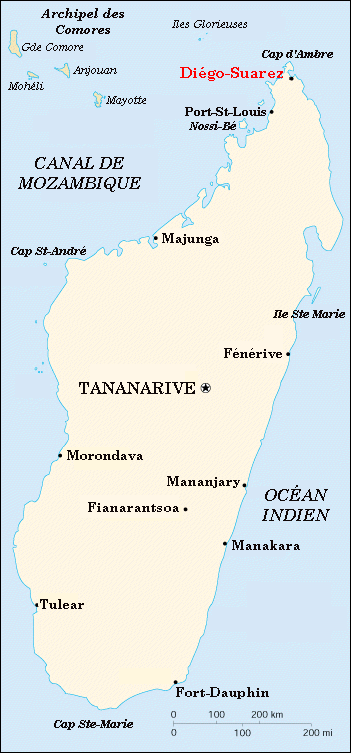 Madagascar
That same month, Captain (later Rear Admiral) Ishizaki Noboru's (former
CO of HYUGA) SubRon 8, forms the Ko ("A") Detachment with Pearl Harbor veteran
submarines I-10, I-16. I-18, I-20, I-30 and I-27 and I-28, converted to carry
midget submarines and auxiliary cruisers/supply ships AIKOKU and HOKOKU MARUs.
Madagascar
That same month, Captain (later Rear Admiral) Ishizaki Noboru's (former
CO of HYUGA) SubRon 8, forms the Ko ("A") Detachment with Pearl Harbor veteran
submarines I-10, I-16. I-18, I-20, I-30 and I-27 and I-28, converted to carry
midget submarines and auxiliary cruisers/supply ships AIKOKU and HOKOKU MARUs.
 Japanese Submarine I-16 on Trials
16 April 1942:
Japanese Submarine I-16 on Trials
16 April 1942:
Hashirajima, Hiroshima Bay. Vice Admiral, the Marquis,
Komatsu Teruhisa (former CO of CA NACHI), CINC, Sixth Fleet (Submarines),
Captain Ishizaki Noboru, ComSubRon 8 and their staffs with Captain Komazawa of
NISSHIN, Captain Harada of CHIYODA, Rear Admiral-Retired (Vice Admiral,
posthumously) Okamura Masao of AMC/supply ship AIKOKU MARU and SubRon 8's midget
submarine crews pay a courtesy call on Admiral Yamamoto aboard his new flagship
YAMATO. Yamamoto wishes the young midget submariners well in their forthcoming
missions in the southern latitudes. At 1100, NISSHIN and the A Detachment
departs for Penang, Malaya. That same day, CHIYODA, with a number of Type A Kai
1 midget submarines and their crews embarked depart Hashirajima as a diversion
for Operation "MI" - the Invasion of Midway.
27 April 1942:
The A detachment's submarines I-16, I-18 and I-20
arrive at Penang and are joined by tender NISSHIN that had earlier been
converted to carry midget submarines.
30 April 1942:
Penang. Each of the three "mother" submarines, less
I-10 and I-30, is loaded with a Type A Kai 1 midget submarine. I-30's plane is
to reconnoiter selected points on the East African coast for possible attack and
departs in advance. I-10, with Captain Ishizaki embarked, and the A Detachment
depart Penang and sortie westward in the Indian Ocean. The I-10's plane is
assigned stand-by duty.
5 May 1942: British “Operation Ironclad” – The Battle of
Madagascar:
Rear Admiral Syfret's invasion convoy of more than 50 Royal Navy
ships approaches Madagascar. It includes HMS RAMILLIES, an old 29,150-ton ROYAL
SOVEREIGN-class battleship, aircraft carriers ILLUSTRIOUS and INDOMITABLE,
cruisers HERMIONE and DEVONSHIRE, destroyers ACTIVE, ANTHONY, DUNCAN,
INCONSTANT, JAVELIN, LAFOREY, LIGHTNING, LOOKOUT, PAKENHAM, PALADIN and PANTHER,
numerous frigates, corvettes and troop transports. The fleet lands assault
forces on the northern tip of the island. ILLUSTRIOUS, INDOMITABLE and RAMILLIES
cover the landings.
As expected, the Vichy French resist. Vichy submarine BEVEZIERS is
attacked and sunk by a flight of British Fairey "Swordfish" and Fairey
"Albacore" torpedo-bombers from ILLUSTRIOUS.
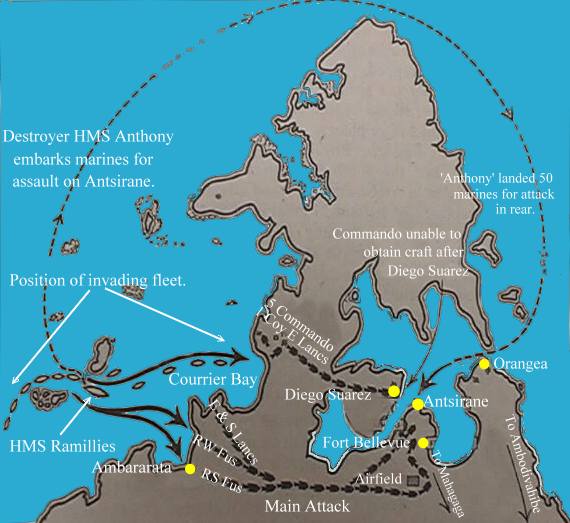 Operation Ironclad – Capture of Diego Suarez
Operation Ironclad – Capture of Diego Suarez
7 May 1942:
About 0500, Vichy French submarine LE HEROS is located
and attacked by a flight of Swordfish from ILLUSTRIOUS. LE HEROS crash dives,
but is forced to the surface and abandoned. In the afternoon, Diego Suarez (now
Antsiranana) is surrendered.
 Vichy French Submarine of the BEVEZIERS and LE HEROS
Type
8 May 1942:
Vichy French Submarine of the BEVEZIERS and LE HEROS
Type
8 May 1942:
At 0756, Vichy submarine MONGE attacks aircraft carrier
HMS INDOMITABLE, but she avoids its torpedoes, one of which passes in the front
of the ship. Destroyers HMS ACTIVE and PANTHER immediately counterattack and
sink the submarine. Vichy forces withdraw to the south and fighting does not end
until November 1942.
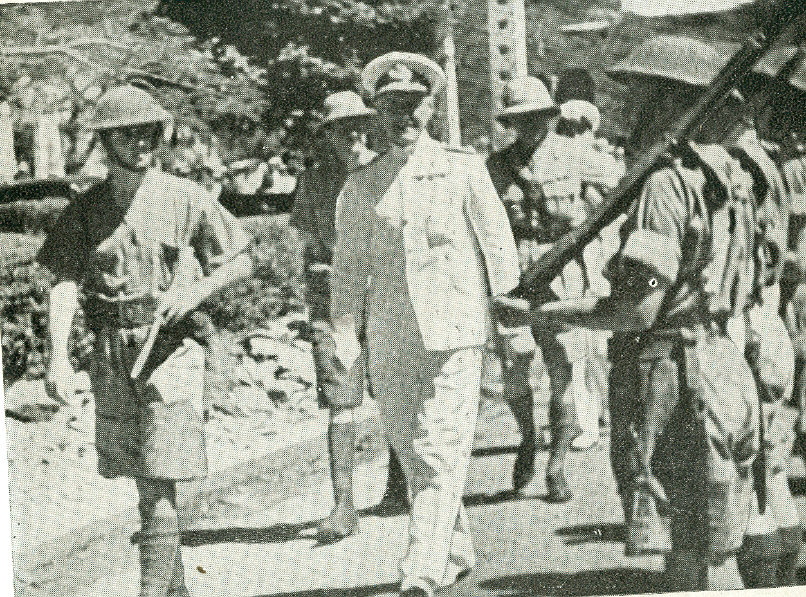 Rear Admiral Syfret at Diego Suarez
5, 10 and 15 May 1942:
Rear Admiral Syfret at Diego Suarez
5, 10 and 15 May 1942:
Indian Ocean. The A Detachment refuels at sea
from AIKOKU and HOKOKU MARUs.
17 May 1942:
Indian Ocean. Indian Ocean. En route, all three "mother”
submarines encounter heavy seas and are repeatedly swamped while charging
batteries. I-20 receives medium damage, which is quickly repaired. I-18's port
diesel is flooded and four cylinders seize. As a result, she and her midget
submarine fail to reach the launch area in time.
29 May 1942:
About 2230, I-10's E14Y "Glen" floatplane piloted by Lt
(j.g.) Araki Toshio and Petty Officer Ito Yoshiharu reconnoiters the harbor at
Diego Suarez. The plane sights HMS RAMILLIES at anchor in the bay. Also in the
harbor are destroyers DUNCAN and ACTIVE, corvettes GENISTA and THYME, troopship
KARANJA, hospital ship ATLANTIS, tanker BRITISH LOYALTY, merchant LLANDAFF
CASTLE and an ammunition ship.
Lt (j.g.) Araki's Glen is sighted and an alert sounded. RAMILLIES weighs
anchor and steams about in the harbor, but later reanchors at a different
location. The floatplane retrurns to I-10. Captain Ishizaki orders a midget
submarine attack for 0230 on 31 May.
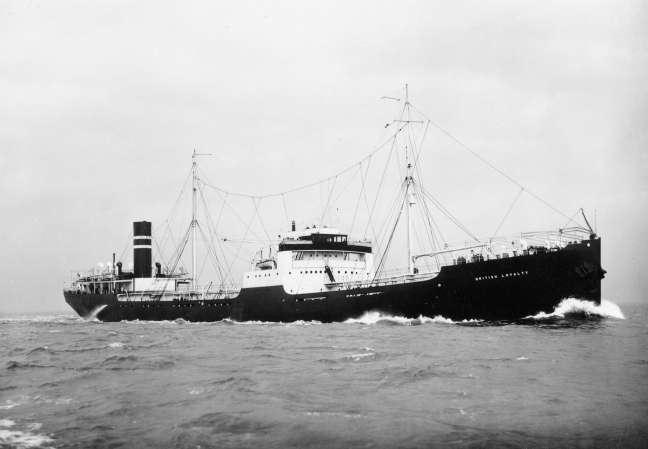 Tanker BRITISH LOYALTY30 May 1942:
Tanker BRITISH LOYALTY30 May 1942:
About 10 miles E of
Diego Suarez. At 1740 (local), I-16 launches Ensign Iwase Katsusuke and PO2C
Takada Kozo's midget submarine M-16b to penetrate the harbor.
At 1710, about 9 nautical miles E of Diego Suarez, I-20 launches Lt
Akieda Saburo and PO1C Takemoto Masami's midget submarine M-20b. At 2025, Lt
Akieda fires one of his two 17.7-inch torpedoes at RAMILLIES. The torpedo holes
the bulge and bottom plating opening a 30-foot by 30-foot hole in the port bulge
forward of "A" turret. The battleship's electrical system suffers damage and
power is lost all over the ship. The six-inch armor belt above the site of the
explosion is displaced and the forward magazines and shell rooms (15-inch main
caliber and 4-inch AA) flood. [3] At 2120, while corvettes drop depth charges
nearby, Akeida fires his other torpedo and sinks 6,993-ton BRITISH LOYALTY in
about 65 feet of water. [4]
31 May 1942:
Akieda and Takemoto depart the bay and head NNW. After
the midget’s battery is depleted, M-20b is beached at Nosy Antalikely (Antali
Keli) islet. Lt Akieda attempts to scuttle his craft, but the charge fails to
explode. Both sailors reach shore and contact natives, who arrange transport to
the mainland. Akieda and Takemoto head for the recovery area near Cape Amber
where I-20 is to wait for two days. [5]
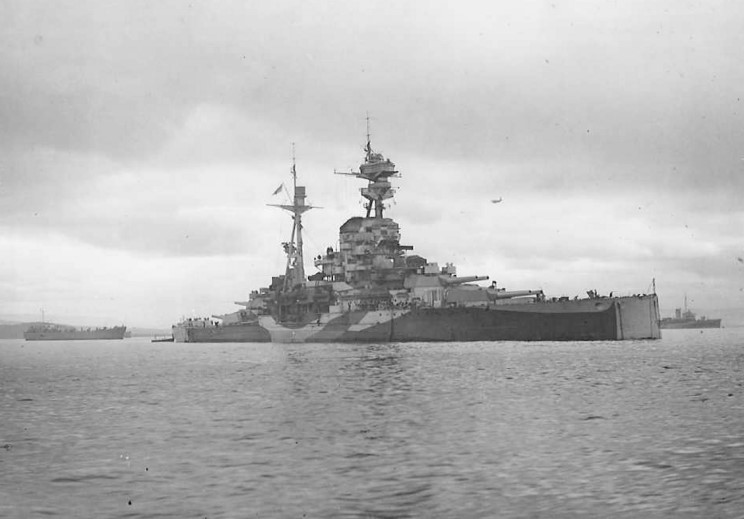 HMS RAMILLIES
Iwase, Takada and midget submarine M-16b go MIA. The wreck of M-16b is
never found.
1 June 1942:
HMS RAMILLIES
Iwase, Takada and midget submarine M-16b go MIA. The wreck of M-16b is
never found.
1 June 1942:
I-18, still carrying her midget submarine M-18b, finally
arrives at the recovery area and joins the search.
Around 1100, Lt Akieda and PO1C Takemoto visit Anijabe village to buy
some food. While most villagers are friendly, one contacts the British hoping to
get a bounty for his information.
2 June 1942:
Amponkarana Bay (12-00S, 49-12E). In the morning. Lt
Akieda and PO1C Takemoto are intercepted by Royal Marines' Commando No. 5 after
the Japanese had made 48 miles on foot. During an ensuing gunfight both Japanese
sailors and one Marine are killed. A watch and a pack of cigarettes with IJN
markings are found, as well as a report addressed to the CO of I-20.
That same day. the body of an unidentified IJN sailor, presumably M-16b's
Iwase or Takada, is found on a beach off Diego Suarez.
Destroyer HMS DECOY arrives with Constructor Captain H. S. Pengelly,
RCNC, Fleet Constructor Officer, Eastern Fleet, aboard. Pengelly inspects HMS
RAMILLIES and confirms she is fit for sea.
3 June 1942:
After the other mother submarines depart the recovery
area, I-20 surfaces and unsuccessfully tries to contact the midget submarines by
firing flares and sending radio signals. At 1800, I-20 leaves the recovery area.
Temporary repairs of HMS RAMILLIES are completed and she departs for
Durban.
9 June 1942:
Mozambique Channel. The day after sinking Norwegian
steamer WILFORD, LtCdr Otani Kiyonori, skipper of I-18 orders midget submarine
M-18b jettisoned.
1972:
A makeshift monument is erected at the place where Akieda and
Takemoto perished.
10 November 1976:
The Japanese Embassy erects a plaque at the same
place with a text in both French and Japanese that says: "Here died two brave
Japanese sailors on 3 June 1942".
 3 July 2001:
3 July 2001:
Japan. The Japanese Maritime Self-Defense Force (JMSDF )
erects a monument to the four midget crews. Present are the crew of JMSDF
training vessel KASHIMA and the ceremony is led by Rear Admiral Yasui Nobuharu.
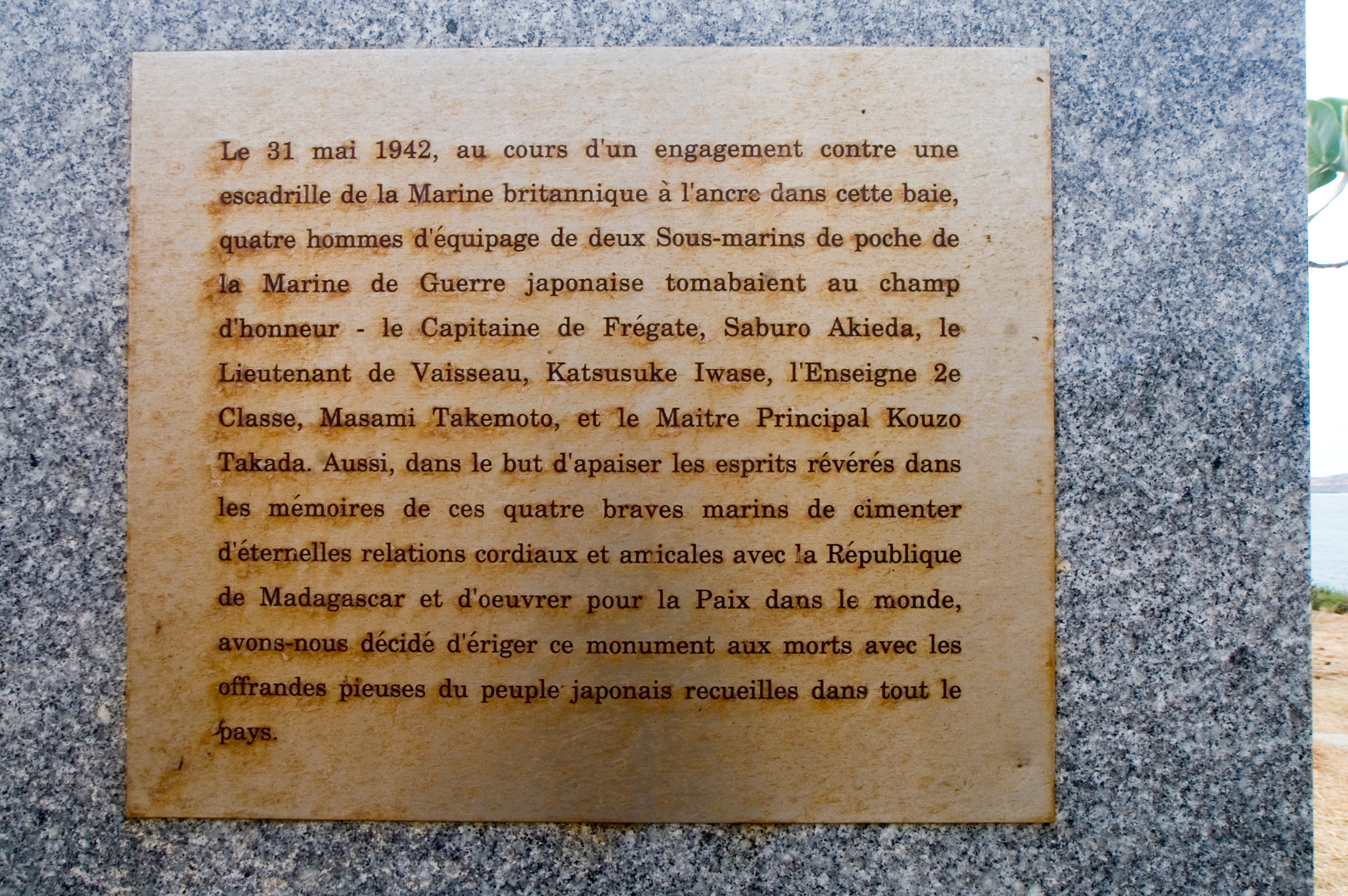
Authors’ Notes:
HA-numbers are unknown for the Diego Suarez midget submarines. We use M-16b and M-18b to differentiate the Diego Suarez midget submarines from Pearl Harbor midget submarines.
[1] Lt ( j.g.) Kanda of HA-13 and his two crewmen were each promoted one
rank, posthumously.
[2] Lt ( j.g.) Ota went on to become navigating officer of the ill-fated
I-52 and perished with her in the Atlantic Ocean in 1944.
[3] Initially, the British thought another Vichy submarine made the
attack and, therefore, did not alert the rest of the fleet. As a result, Sydney,
Australia received no warning. After emergency repairs, RAMILLIES made for
Durban, Union of South Africa where she was docked for temporary repairs from
June to August 1942. Later, RAMILLIES returned to Plymouth, England where full
repairs were completed from September 1942 to June 1943. In June 1944, RAMILLIES
participated in the D-Day invasion.
[4] BRITISH LOYALTY was later refloated and towed to Addu Atoll where, on
9 Mar '44, she was torpedoed and damaged by German submarine U-183. On 15 Jan
'46, BRITISH LOYALTY was scuttled and sank off Addu Atoll.
[5] The limited remains of Akieda and Takemoto's midget submarine "M-20b"
were found about two weeks after the attack sitting upright on a reef within an
area of volatile surf. According to historian/author Kimata Jiro, a recent NHK
documentary showed the aft section (now completely submerged) in the same
location. The propellers were salvaged and are on display at the midget
submariners’ grave site.
Thanks go to Caspar Vermeulen of the Netherlands for contributing the photo of the latest
french language marker erected by the JMSDF. He says the new monument is located on top of a French search light
position, located at the north eastern tip of the city, behind the local hospital.
-Bob Hackett and Sander Kingsepp
Back to Submarine
Page
















